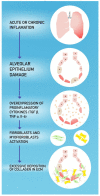COVID-19: The Potential Treatment of Pulmonary Fibrosis Associated with SARS-CoV-2 Infection
- PMID: 32575380
- PMCID: PMC7356800
- DOI: 10.3390/jcm9061917
COVID-19: The Potential Treatment of Pulmonary Fibrosis Associated with SARS-CoV-2 Infection
Abstract
In December 2019, a novel coronavirus, SARS-CoV-2, appeared, causing a wide range of symptoms, mainly respiratory infection. In March 2020, the World Health Organization (WHO) declared Coronavirus Disease 2019 (COVID-19) a pandemic, therefore the efforts of scientists around the world are focused on finding the right treatment and vaccine for the novel disease. COVID-19 has spread rapidly over several months, affecting patients across all age groups and geographic areas. The disease has a diverse course; patients may range from asymptomatic to those with respiratory failure, complicated by acute respiratory distress syndrome (ARDS). One possible complication of pulmonary involvement in COVID-19 is pulmonary fibrosis, which leads to chronic breathing difficulties, long-term disability and affects patients' quality of life. There are no specific mechanisms that lead to this phenomenon in COVID-19, but some information arises from previous severe acute respiratory syndrome (SARS) or Middle East respiratory syndrome (MERS) epidemics. The aim of this narrative review is to present the possible causes and pathophysiology of pulmonary fibrosis associated with COVID-19 based on the mechanisms of the immune response, to suggest possible ways of prevention and treatment.
Keywords: ARDS; COVID-19; SARI; SARS-CoV-2; coronavirus; pathophysiology; pneumonia; pulmonary fibrosis; treatment.
Conflict of interest statement
The authors declare no conflict of interest.
Figures
References
-
- Wuhan Municipal Health Commission Report of Clustering Pneumonia of Unknown Etiology in Wuhan City. [(accessed on 18 June 2020)];2019 Wuhan. Available online: wjw.wuhan.gov.cn.
-
- World Health Organization . General’s Opening Remarks at the Media Briefing on COVID-19-18 March 2020. World Health Organization; Geneva, Switzerland: 2020.
-
- World Health Organization . Coronavirus Disease (COVID-2019) Situation Reports. World Health Organization; Geneva, Switzerland: 2020. Coronavirus Disease (COVID-2019) Situation Report—101.
-
- World Health Organization Coronavirus Disease (COVID-2019) Situation Reports. [(accessed on 13 April 2020)]; Available online: https://www.who.int/emergencies/diseases/novel-coronavirus-2019/situatio....
-
- Chan J.F., Yuan S., Kok K.H., To K.K., Chu H., Yang J., Xing F., Liu J., Yip C.C., Poon R.W., et al. A familial cluster of pneumonia associated with the 2019 novel coronavirus indicating person-to-person transmission: A study of a family cluster. Lancet. 2020;395:514–523. doi: 10.1016/S0140-6736(20)30154-9. - DOI - PMC - PubMed
Publication types
LinkOut - more resources
Full Text Sources
Other Literature Sources
Medical
Miscellaneous




